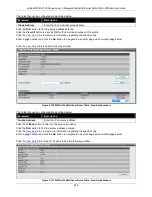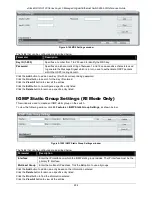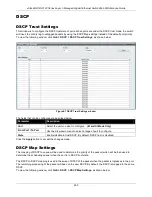
xStack® DGS-3120 Series Layer 3 Managed Gigabit Ethernet Switch Web UI Reference Guide
255
Chapter 6
QoS
802.1p Settings
Bandwidth Control
Traffic Control Settings
DSCP
HOL Blocking Prevention
Scheduling Settings
WRED
The Switch supports 802.1p priority queuing Quality of Service. The following section discusses the implementation
of QoS (Quality of Service) and benefits of using 802.1p priority queuing.
Advantages of QoS
QoS is an implementation of the IEEE 802.1p standard that allows network administrators a method of reserving
bandwidth for important functions that require a large bandwidth or have a high priority, such as VoIP (voice-over
Internet Protocol), web browsing applications, file server applications or video conferencing. Not only can a larger
bandwidth be created, but other less critical traffic can be limited, so excessive bandwidth can be saved. The
Switch has separate hardware queues on every physical port to which packets from various applications can be
mapped to, and, in turn prioritized. View the following map to see how the Switch implements basic 802.1P priority
queuing.
Figure 6-1 Mapping QoS on the Switch
The picture above shows the default priority setting for the Switch. Class-7 has the highest priority of the seven
priority classes of service on the Switch. In order to implement QoS, the user is required to instruct the Switch to
examine the header of a packet to see if it has the proper identifying tag. Then the user may forward these tagged
packets to designated classes of service on the Switch where they will be emptied, based on priority.
For example, let’s say a user wishes to have a video conference between two remotely set computers. The
administrator can add priority tags to the video packets being sent out, utilizing the Access Profile commands. Then,
on the receiving end, the administrator instructs the Switch to examine packets for this tag, acquires the tagged
packets and maps them to a class queue on the Switch. Then in turn, the administrator will set a priority for this
queue so that will be emptied before any other packet is forwarded. This result in the end user receiving all packets
sent as quickly as possible, thus prioritizing the queue and allowing for an uninterrupted stream of packets, which
optimizes the use of bandwidth available for the video conference.
Summary of Contents for xStack DGS-3120 Series
Page 1: ......
















































